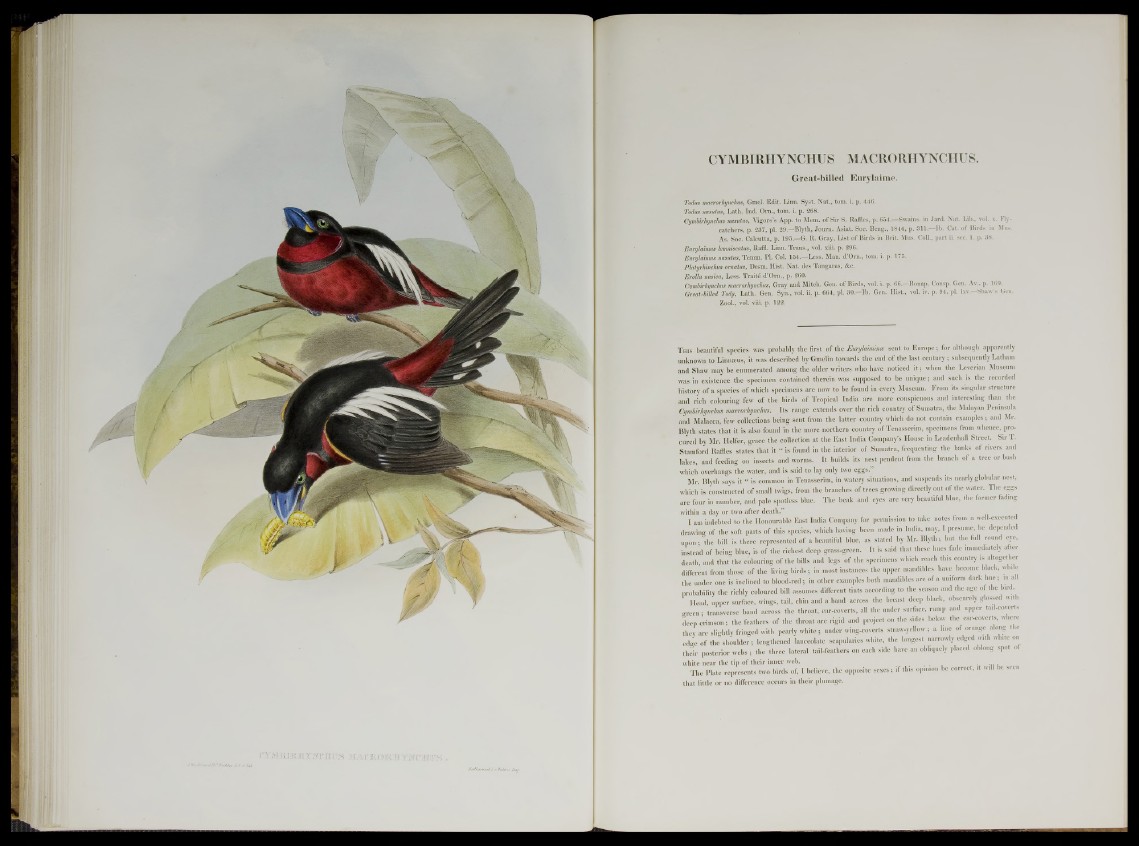
CYMBIRHYNCHUS MACRORHYNCHUS.
Great-billed Eurylaime.
Todus macrorhynchus, Gmel. Edit. Linn. Syst. Nat., tom. i. p. 446.
Todus nasutus, Lath. Ind. Om., tom. i. p. 268.
GymbvrhyncJms nasutus, Vigors’s App. to Mem. of Sir S. Raffles, p. 654.—Swains, in Jard. Nat. Lib., vol. x. Flycatchers,
p. 237, pi. 29.—Blyth, Joum. Asiat. Soc. Beng., 1846, p. 311.—Ib. Cat. of Birds in Mus.
As. Soc. Calcutta, p. 195.—G. R. Gray, List of Birds in Brit. Mus. Coll., part ii. sec. 1. p. 38.
Eurylaimus lemniscatus, Raffl. Linn. Trans., vol. xiii. p. 296.
Eurylaimus nasutus, Temm. PI. Col. 154.—Less. Man. d’Om., tom. i. p. 175.
Platyrhinchus ornatus, Desm. Hist. Nat. des Tangaras, &c.
Erolla nasica, Less. Traité d’Om., p. 260.
Cymbirhynchus macrorhynchus, Gray and Mitch. Gen. of Birds, vol. i. p. 66. Bonap. Consp. Gen. Av., p. 169.
Great-billed Tody, Lath. Gen. Syn., vol. ii. p. 664, pi. 3 0 .-Ib . Gen. Hist., vol. iv. p. 94, pi. lxv—Shaw’s Gen.
Zool., vol. viii. p. 122.
T his beautiful species was probably the first of the Eurylaimince sent to Europe ; for although apparently
unknown to Linnams, it was described by Gmelin towards the end of the last century ; subsequently Latham
and Shaw may be enumerated among the older writers who have noticed it ; when the Leverian Museum
was in existence the specimen contained therein was supposed to be unique ; and such is the recorded
history of a species of which specimens are now to be found in every Museum. From its singular structure
and rich colouring few of the birds of Tropical India are more conspicuous and interesting than the
Cymbirhynchus macrorhynchus. Its range extends over the rich country of Sumatra, the Malayan Peninsula
and Malacca, few collections being sent from the latter country which do not contain examples ; and Mr.
Blyth states that it is also found in the more northern country of Tenasserim, specimens from whence, procured
by Mr. Heifer, grace the collection at the East India Company’s House in Leadenhall Street. Sir T.
Stamford Raffles states that it “ is found in the interior of Sumatra, frequenting the banks of rivers and
lakes, and feeding on insects and worms. It builds its nest pendent from the branch of a tree or bush
which overhangs the water, and is said to lay only two eggs.”
Mr. Blyth says it “ is common in Tenasserim, in watery situations, and suspends its nearly globular nest,
which is constructed of small twigs, from the branches of trees growing directly out of the water. The eggs
are four in number, and pale spotless bine. The beak and eyes are very beautiful blue, the former fading
within a day or two after death.”
I am indebted to the Honourable East India Company for permission to take notes from a well-executed
drawing of the soft parts of this species, which having been made in India, may, I presume, be depended
upon • the bill is there represented of a beautiful blue, as stated by Mr. Blyth ; but the full round eye,
instead of being blue, is of the richest deep grass-green. It is said that these hues fade immediately after
death, and that the colouring of the bills and legs of the specimens which reach this country is altogether
different from those of the living birds; in most instances the upper mandibles have become black, while
the under one is inclined to blood-red ; in other examples both mandibles are of a uniform dark hue ; in all
probability the richly coloured bill assumes different tints according to the season and the age of the bird.
Head, upper surface, wings, tail, chin and a band across the breast deep black, obscurely glossed with
green ; transverse band across the throat, ear-coverts, all the under surface, rump and upper tail-coverts
deep crimson : the feathers of the throat are rigid and project on the sides below the ear-coverts, where
they are slightly fringed with pearly white ; under wing-coverts straw-yellow ; a line of orange along the
edge of the shoulder; lengthened lanceolate scapularies white, the longest narrowly edged with white on
their posterior webs; the three lateral tail-feathers on each side have an obliquely placed oblong spot ol
white near the tip of their inner web. |
The Plate represents two birds of, I believe, the opposite sexes ; if this opinion be correct, it will be seen
that little or no difference occurs in their plumage.